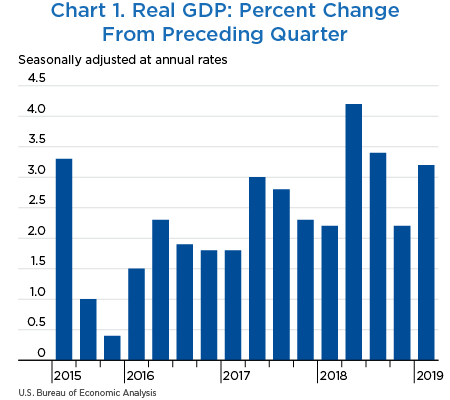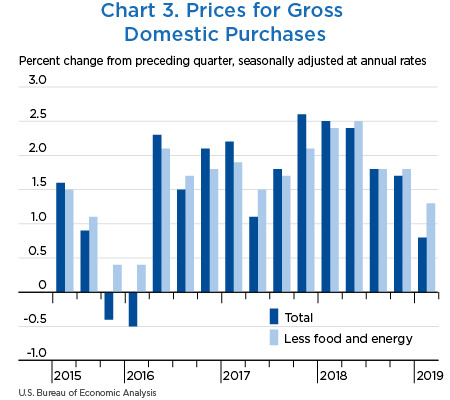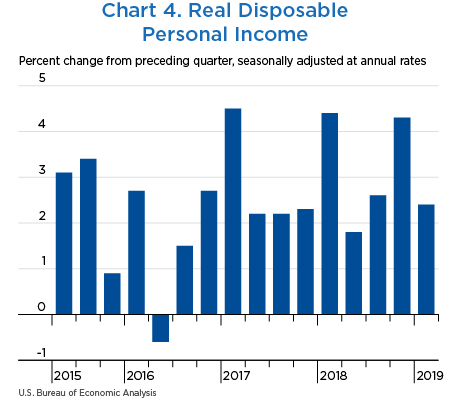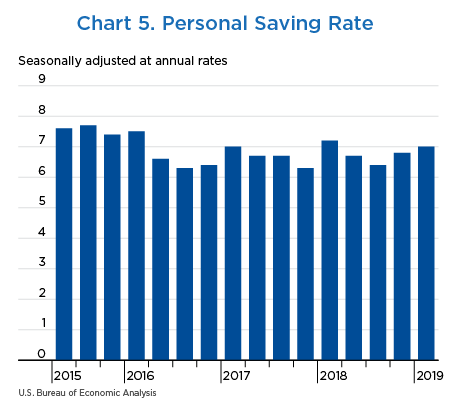GDP and the Economy
Advance Estimates for the First Quarter of 2019
Real gross domestic product (GDP) increased at an annual rate of 3.2 percent in the first quarter of 2019, according to the advance estimates of the National Income and Product Accounts (NIPAs) (chart 1 and table 1).1 In the fourth quarter of 2018, real GDP increased 2.2 percent.
The increase in real GDP in the first quarter reflected positive contributions from consumer spending, inventory investment, exports, state and local government spending, and nonresidential fixed investment.2 Imports, which are a subtraction in the calculation of GDP, decreased (chart 2 and table 1).
The acceleration in real GDP in the first quarter reflected an upturn in state and local government spending (line 26), accelerations in inventory investment (line 14) and in exports (line 16), and a smaller decrease in residential investment (line 13). These movements were partly offset by decelerations in consumer spending (line 2) and nonresidential fixed investment (line 9) and a downturn in federal government spending (line 23). Imports, which are a subtraction in the calculation of GDP, turned down (line 19).
- The upturn in state and local government spending primarily reflected an upturn in gross investment on structures.
- The acceleration in inventory investment primarily reflected an upturn in manufacturing inventory investment, for both durable and nondurable-goods industries.
- The acceleration in exports primarily reflected upturns in foods, feeds, and beverages and in automotive vehicles, engines, and parts. These movements were partly offset by downturns in industrial supplies and materials and in nonautomotive capital goods.
- The smaller decrease in residential investment primarily reflected an upturn in brokers' commissions and other ownership transfer costs following four consecutive quarters of decline.
- The deceleration in consumer spending primarily reflected a downturn in goods, mainly for spending on new motor vehicles (most notably, new light-truck purchases). Spending on services also decelerated, primarily reflecting a downturn in spending by nonprofit institutions serving households (most notably, professional advocacy, and hospitals) that was partly offset by accelerations in spending for health care and for financial services and insurance.
- The downturn in federal government spending reflected a downturn in gross investment for defense equipment (mainly aircraft).
- The downturn in imports reflected downturns in both goods and services. Within goods imports, the downturn was widespread; the leading contributors were a downturn in motor vehicles and a smaller increase in consumer goods (nonfood, nonautomotive). Within services imports, travel services and transport services both turned down.
| Line | Share of current-dollar GDP (percent) | Change from preceding period (percent) | Contribution to percent change in real GDP (percentage points) | |||||||
|---|---|---|---|---|---|---|---|---|---|---|
| 2019 | 2018 | 2019 | 2018 | 2019 | ||||||
| I | II | III | IV | I | II | III | IV | I | ||
| 1 | Gross domestic product1 | 100.0 | 4.2 | 3.4 | 2.2 | 3.2 | 4.2 | 3.4 | 2.2 | 3.2 |
| 2 | Personal consumption expenditures | 67.7 | 3.8 | 3.5 | 2.5 | 1.2 | 2.57 | 2.37 | 1.66 | 0.82 |
| 3 | Goods | 20.7 | 5.5 | 4.3 | 2.6 | −0.7 | 1.16 | 0.90 | 0.54 | −0.14 |
| 4 | Durable goods | 6.9 | 8.6 | 3.7 | 3.6 | −5.3 | 0.60 | 0.26 | 0.25 | −0.38 |
| 5 | Nondurable goods | 13.8 | 4.0 | 4.6 | 2.1 | 1.7 | 0.56 | 0.64 | 0.29 | 0.24 |
| 6 | Services | 47.0 | 3.0 | 3.2 | 2.4 | 2.0 | 1.42 | 1.47 | 1.12 | 0.96 |
| 7 | Gross private domestic investment | 18.1 | −0.5 | 15.2 | 3.7 | 5.1 | −0.07 | 2.53 | 0.66 | 0.92 |
| 8 | Fixed investment | 17.5 | 6.4 | 1.1 | 3.1 | 1.5 | 1.10 | 0.21 | 0.54 | 0.27 |
| 9 | Nonresidential | 13.7 | 8.7 | 2.5 | 5.4 | 2.7 | 1.15 | 0.35 | 0.73 | 0.38 |
| 10 | Structures | 3.1 | 14.5 | −3.4 | −3.9 | −0.8 | 0.43 | −0.11 | −0.12 | −0.02 |
| 11 | Equipment | 6.0 | 4.6 | 3.4 | 6.6 | 0.2 | 0.27 | 0.21 | 0.39 | 0.01 |
| 12 | Intellectual property products | 4.7 | 10.5 | 5.6 | 10.7 | 8.6 | 0.45 | 0.25 | 0.46 | 0.39 |
| 13 | Residential | 3.8 | −1.3 | −3.6 | −4.7 | −2.8 | −0.05 | −0.14 | −0.18 | −0.11 |
| 14 | Change in private inventories | 0.6 | ...... | ...... | ...... | ...... | −1.17 | 2.33 | 0.11 | 0.65 |
| 15 | Net exports of goods and services | −2.9 | ...... | ...... | ...... | ...... | 1.22 | −1.99 | −0.08 | 1.03 |
| 16 | Exports | 12.1 | 9.3 | −4.9 | 1.8 | 3.7 | 1.12 | −0.62 | 0.22 | 0.45 |
| 17 | Goods | 7.9 | 13.5 | −8.4 | 1.2 | 4.7 | 1.06 | −0.72 | 0.10 | 0.37 |
| 18 | Services | 4.2 | 1.5 | 2.4 | 2.7 | 1.8 | 0.07 | 0.10 | 0.11 | 0.08 |
| 19 | Imports | 14.9 | −0.6 | 9.3 | 2.0 | −3.7 | 0.10 | −1.37 | −0.30 | 0.58 |
| 20 | Goods | 12.1 | −0.4 | 10.5 | 0.5 | −4.4 | 0.06 | −1.24 | −0.06 | 0.56 |
| 21 | Services | 2.9 | −1.4 | 4.3 | 8.6 | −0.8 | 0.04 | −0.12 | −0.24 | 0.02 |
| 22 | Government consumption expenditures and gross investment | 17.1 | 2.5 | 2.6 | −0.4 | 2.4 | 0.43 | 0.44 | −0.07 | 0.41 |
| 23 | Federal | 6.4 | 3.7 | 3.5 | 1.1 | 0.0 | 0.24 | 0.23 | 0.07 | 0.00 |
| 24 | National defense | 3.8 | 5.9 | 4.9 | 6.4 | 4.1 | 0.22 | 0.18 | 0.24 | 0.16 |
| 25 | Nondefense | 2.6 | 0.5 | 1.6 | −6.1 | −5.9 | 0.01 | 0.04 | −0.16 | −0.16 |
| 26 | State and local | 10.7 | 1.8 | 2.0 | −1.3 | 3.9 | 0.20 | 0.22 | −0.14 | 0.41 |
| Addenda: | ||||||||||
| 27 | Gross domestic income (GDI)2 | ...... | 0.9 | 4.6 | 1.7 | ...... | ...... | ...... | ...... | ...... |
| 28 | Average of GDP and GDI | ...... | 2.5 | 4.0 | 1.9 | ...... | ...... | ...... | ...... | ...... |
| 29 | Final sales of domestic product | 99.4 | 5.4 | 1.0 | 2.1 | 2.5 | 5.33 | 1.03 | 2.05 | 2.53 |
| 30 | Goods | 29.6 | 6.5 | 6.1 | 5.7 | 6.5 | 1.91 | 1.77 | 1.66 | 1.90 |
| 31 | Services | 62.0 | 2.9 | 2.8 | 1.6 | 1.8 | 1.78 | 1.76 | 0.99 | 1.09 |
| 32 | Structures | 8.4 | 5.5 | −2.0 | −5.5 | 2.2 | 0.47 | −0.17 | −0.48 | 0.18 |
| 33 | Motor vehicle output | 2.7 | −5.8 | 9.6 | 3.3 | −5.0 | −0.17 | 0.25 | 0.09 | −0.14 |
| 34 | GDP excluding motor vehicle output | 97.3 | 4.5 | 3.2 | 2.1 | 3.4 | 4.33 | 3.10 | 2.08 | 3.31 |
- The GDP estimates under the contribution columns are also percent changes.
- GDI is deflated by the implicit price deflator for GDP.
Prices for gross domestic purchases, goods and services purchased by U.S. residents, increased 0.8 percent in the first quarter after increasing 1.7 percent in the fourth quarter (table 2, line 1, and chart 3). The deceleration primarily reflected a deceleration in prices paid for consumer services (led by a downturn in financial services and insurance). Food prices accelerated (line 20), increasing 3.0 percent after increasing 0.2 percent. Energy goods and services decreased 16.7 percent in the first quarter after decreasing 1.6 percent in the fourth quarter (line 21). Gross domestic purchases prices excluding food and energy (line 22) decelerated, increasing 1.3 percent in the first quarter after increasing 1.8 percent in the fourth quarter.
Consumer prices excluding food and energy (line 25), a measure of the “core” rate of inflation, decelerated, increasing 1.3 percent in the first quarter after increasing 1.8 percent in the fourth quarter.
| Line | Change from preceding period (percent) | Contribution to percent change in gross domestic purchases prices (percentage points) | |||||||
|---|---|---|---|---|---|---|---|---|---|
| 2018 | 2019 | 2018 | 2019 | ||||||
| II | III | IV | I | II | III | IV | I | ||
| 1 | Gross domestic purchases1 | 2.4 | 1.8 | 1.7 | 0.8 | 2.4 | 1.8 | 1.7 | 0.8 |
| 2 | Personal consumption expenditures | 2.0 | 1.6 | 1.5 | 0.6 | 1.32 | 1.04 | 0.98 | 0.39 |
| 3 | Goods | 0.4 | −0.4 | −1.1 | −1.7 | 0.08 | −0.07 | −0.23 | −0.35 |
| 4 | Durable goods | −1.6 | −0.9 | −1.5 | −0.4 | −0.11 | −0.06 | −0.10 | −0.03 |
| 5 | Nondurable goods | 1.4 | 0.0 | −1.0 | −2.4 | 0.19 | −0.01 | −0.13 | −0.32 |
| 6 | Services | 2.7 | 2.5 | 2.7 | 1.6 | 1.24 | 1.11 | 1.22 | 0.74 |
| 7 | Gross private domestic investment | 3.1 | 2.0 | 1.4 | 1.4 | 0.53 | 0.35 | 0.25 | 0.24 |
| 8 | Fixed investment | 3.2 | 2.0 | 1.4 | 1.4 | 0.53 | 0.34 | 0.24 | 0.24 |
| 9 | Nonresidential | 2.0 | 1.6 | 1.1 | 1.3 | 0.26 | 0.21 | 0.14 | 0.17 |
| 10 | Structures | 5.1 | 3.1 | 5.8 | 2.5 | 0.15 | 0.09 | 0.17 | 0.07 |
| 11 | Equipment | 0.8 | 1.2 | −0.7 | 0.6 | 0.05 | 0.07 | −0.04 | 0.03 |
| 12 | Intellectual property products | 1.4 | 1.0 | 0.3 | 1.5 | 0.06 | 0.04 | 0.01 | 0.07 |
| 13 | Residential | 7.3 | 3.6 | 2.6 | 1.8 | 0.27 | 0.13 | 0.10 | 0.07 |
| 14 | Change in private inventories | ...... | ...... | ...... | ...... | −0.01 | 0.01 | 0.01 | 0.00 |
| 15 | Government consumption expenditures and gross investment | 3.3 | 2.5 | 2.6 | 1.1 | 0.55 | 0.41 | 0.42 | 0.18 |
| 16 | Federal | 2.0 | 1.5 | 2.7 | 4.2 | 0.13 | 0.10 | 0.16 | 0.26 |
| 17 | National defense | 1.3 | 1.2 | 1.6 | 0.8 | 0.05 | 0.04 | 0.06 | 0.03 |
| 18 | Nondefense | 3.0 | 2.0 | 4.2 | 9.3 | 0.08 | 0.05 | 0.10 | 0.22 |
| 19 | State and local | 4.1 | 3.0 | 2.5 | −0.7 | 0.42 | 0.32 | 0.26 | −0.07 |
| Addenda: | |||||||||
| Gross domestic purchases: | |||||||||
| 20 | Food | 1.1 | 0.5 | 0.2 | 3.0 | 0.05 | 0.03 | 0.01 | 0.14 |
| 21 | Energy goods and services | 0.4 | 3.3 | −1.6 | −16.7 | 0.01 | 0.09 | −0.04 | −0.49 |
| 22 | Excluding food and energy | 2.5 | 1.8 | 1.8 | 1.3 | 2.33 | 1.68 | 1.68 | 1.16 |
| Personal consumption expenditures: | |||||||||
| 23 | Food and beverages purchased for off-premises consumption | 1.2 | 0.4 | 0.3 | 3.0 | ...... | ...... | ...... | ...... |
| 24 | Energy goods and services | 0.7 | 3.3 | −2.0 | −16.8 | ...... | ...... | ...... | ...... |
| 25 | Excluding food and energy | 2.1 | 1.6 | 1.8 | 1.3 | ...... | ...... | ...... | ...... |
| 26 | Gross domestic product | 3.0 | 1.8 | 1.7 | 0.9 | ...... | ...... | ...... | ...... |
| 27 | Exports of goods and services | 5.8 | 0.3 | −1.4 | −3.3 | ...... | ...... | ...... | ...... |
| 28 | Imports of goods and services | 0.8 | 0.4 | −1.0 | −3.0 | ...... | ...... | ...... | ...... |
- The estimates under the contribution columns are also percent changes.
Personal income (table 3, line 1), which is measured in current dollars, increased $147.2 billion in the first quarter after increasing $229.0 billion in the fourth quarter. The deceleration reflected downturns in personal interest income (line 17), personal dividend income (line 18), and proprietors’ income (line 12) that were partly offset by an acceleration in personal current transfer receipts (line 19).
Personal current taxes (line 29) increased $31.1 billion in the first quarter after increasing $6.1 billion in the fourth quarter.
Disposable personal income (DPI) (line 30 and chart 4) increased $116.0 billion in the first quarter after increasing $222.9 billion in the fourth quarter.
The personal saving rate (line 33 and chart 5)—personal saving as a percentage of DPI—was 7.0 percent in the first quarter; in the fourth quarter, the personal saving rate was 6.8 percent.
Real DPI (line 35) increased 2.4 percent in the first quarter after increasing 4.3 percent in the fourth quarter. Current-dollar DPI (line 34) increased 3.0 percent after increasing 5.8 percent. The differences in the movements in real DPI and current-dollar DPI reflected a deceleration in the implicit price deflator for consumer spending, which is used to deflate DPI.
| Line | Level | Change from preceding period | |||||
|---|---|---|---|---|---|---|---|
| 2018 | 2019 | 2018 | 2019 | ||||
| IV | I | II | III | IV | I | ||
| 1 | Personal income | 17,886.3 | 18,033.5 | 147.6 | 190.6 | 229.0 | 147.2 |
| 2 | Compensation of employees | 11,023.0 | 11,139.3 | 72.8 | 125.0 | 115.1 | 116.4 |
| 3 | Wages and salaries | 8,979.2 | 9,078.9 | 60.2 | 108.4 | 100.0 | 99.7 |
| 4 | Private industries | 7,584.8 | 7,675.4 | 52.0 | 94.0 | 91.2 | 90.6 |
| 5 | Goods-producing industries | 1,486.6 | 1,497.7 | −3.1 | 19.0 | 18.5 | 11.1 |
| 6 | Manufacturing | 889.1 | 891.7 | −7.1 | 9.8 | 8.4 | 2.6 |
| 7 | Services-producing industries | 6,098.2 | 6,177.7 | 55.1 | 75.0 | 72.8 | 79.5 |
| 8 | Trade, transportation, and utilities | 1,378.6 | 1,395.0 | 6.8 | 14.1 | 12.9 | 16.4 |
| 9 | Other services-producing industries | 4,719.6 | 4,782.7 | 48.3 | 60.9 | 59.9 | 63.1 |
| 10 | Government | 1,394.4 | 1,403.5 | 8.1 | 14.4 | 8.8 | 9.1 |
| 11 | Supplements to wages and salaries | 2,043.8 | 2,060.5 | 12.6 | 16.6 | 15.1 | 16.7 |
| 12 | Proprietors' income with IVA and CCAdj | 1,616.7 | 1,602.1 | 18.6 | 11.5 | 36.7 | −14.6 |
| 13 | Farm | 47.9 | 36.1 | 1.8 | −9.1 | 19.9 | −11.8 |
| 14 | Nonfarm | 1,568.9 | 1,566.1 | 16.8 | 20.6 | 16.8 | −2.8 |
| 15 | Rental income of persons with CCAdj | 768.6 | 781.1 | 5.0 | 13.2 | 1.2 | 12.5 |
| 16 | Personal income receipts on assets | 2,833.4 | 2,784.7 | 28.3 | 24.4 | 61.3 | −48.7 |
| 17 | Personal interest income | 1,645.6 | 1,616.4 | 8.9 | 9.7 | 29.4 | −29.1 |
| 18 | Personal dividend income | 1,187.9 | 1,168.3 | 19.3 | 14.7 | 31.9 | −19.6 |
| 19 | Personal current transfer receipts | 3,025.8 | 3,129.3 | 31.9 | 31.4 | 28.6 | 103.6 |
| 20 | Government social benefits to persons | 2,963.2 | 3,066.3 | 29.7 | 30.2 | 27.6 | 103.1 |
| 21 | Social security | 989.0 | 1,022.7 | 8.2 | 8.7 | 11.3 | 33.6 |
| 22 | Medicare | 759.5 | 782.5 | 10.8 | 15.4 | 19.6 | 23.0 |
| 23 | Medicaid | 604.6 | 608.0 | 12.3 | 5.2 | −3.2 | 3.5 |
| 24 | Unemployment insurance | 24.1 | 25.2 | −2.0 | −0.8 | −0.6 | 1.0 |
| 25 | Veterans' benefits | 113.1 | 116.4 | 2.4 | 3.0 | 2.1 | 3.3 |
| 26 | Other | 472.9 | 511.6 | −2.0 | −1.3 | −1.6 | 38.7 |
| 27 | Other current transfer receipts, from business (net) | 62.6 | 63.0 | 2.2 | 1.2 | 1.0 | 0.4 |
| 28 | Less: Contributions for government social insurance | 1,381.2 | 1,403.1 | 8.9 | 14.9 | 13.8 | 21.9 |
| 29 | Less: Personal current taxes | 2,071.0 | 2,102.1 | 5.3 | 29.6 | 6.1 | 31.1 |
| 30 | Equals: Disposable personal income (DPI) | 15,815.3 | 15,931.4 | 142.3 | 160.9 | 222.9 | 116.0 |
| 31 | Less: Personal outlays | 14,744.1 | 14,820.1 | 208.9 | 192.6 | 147.7 | 76.0 |
| 32 | Equals: Personal saving | 1,071.3 | 1,111.3 | −66.7 | −31.6 | 75.2 | 40.0 |
| 33 | Personal saving as a percentage of DPI | 6.8 | 7.0 | ...... | ...... | ...... | ...... |
| Addenda: | |||||||
| Percent change at annual rate | |||||||
| 34 | Current-dollar DPI | ...... | ...... | 3.8 | 4.2 | 5.8 | 3.0 |
| 35 | Real DPI, chained (2012) dollars | ...... | ...... | 1.8 | 2.6 | 4.3 | 2.4 |
- “Real” estimates are in chained (2012) dollars, and price indexes are chain-type measures. Each GDP estimate for a quarter (advance, second, and third) incorporates increasingly comprehensive and improved source data; for more information, see “The Revisions to GDP, GDI, and Their Major Components” in the January 2018 Survey of Current Business. Quarterly estimates are expressed at seasonally adjusted annual rates, which reflect a rate of activity for a quarter as if it were maintained for a year.
- In this article, “consumer spending” refers to “personal consumption expenditures,” “inventory investment” refers to “change in private inventories,” and “government spending” refers to “government consumption expenditures and gross investment.”




